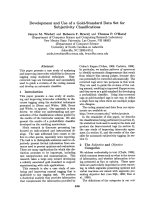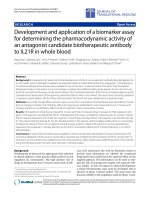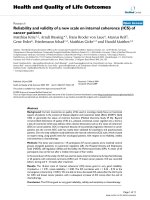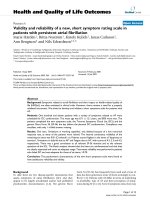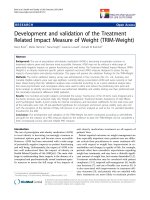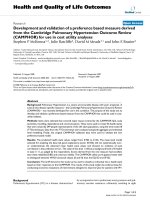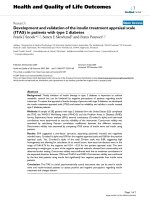báo cáo hóa học: " Development and evaluation of a computer-based medical work assessment programme" pdf
Bạn đang xem bản rút gọn của tài liệu. Xem và tải ngay bản đầy đủ của tài liệu tại đây (638.92 KB, 5 trang )
BioMed Central
Page 1 of 5
(page number not for citation purposes)
Journal of Occupational Medicine
and Toxicology
Open Access
Methodology
Development and evaluation of a computer-based medical work
assessment programme
Stefanie Mache*
1,2,3
, Cristian Scutaru
1,2
, Karin Vitzthum
1,2
,
Alexander Gerber
1
, David Quarcoo
1
, Tobias Welte
2
, Torsten T Bauer
5
,
Michael Spallek
1
, Andreas Seidler
4
, Albert Nienhaus
6
, Burghard F Klapp
3
and
David A Groneberg
1
Address:
1
Institute of Occupational Medicine, Charité – Universitätsmedizin Berlin, Free University and Humboldt University, Thielallee 69-73,
14195 Berlin, Germany,
2
Department of Respiratory Medicine, Hannover Medical School, Carl-Neuberg-Straße 1, 30625 Hannover, Germany,
3
Department of Medicine/Psychosomatics, Charité – Universitätsmedizin Berlin, Free University and Humboldt University, Luisenstrasse 13a,
10117 Berlin, Germany,
4
The Federal Institute for Occupational Safety and Health, Nöldnerstr. 40-42, 10317 Berlin, Germany,
5
City Hospital Emil
von Behring/Lungenklinik Heckeshorn, Walterhöferstrasse 11, 14165 Berlin, Germany and
6
Institution for Statutory Accident Insurance in the
Health and Welfare Services, Pappelallee 35/37, 22089 Hamburg, Germany
Email: Stefanie Mache* - ; Cristian Scutaru - ; Karin Vitzthum - ;
Alexander Gerber - ; David Quarcoo - ; Tobias Welte - ;
Torsten T Bauer - ; Michael Spallek - ;
Andreas Seidler - ; Albert Nienhaus - ;
Burghard F Klapp - ; David A Groneberg -
* Corresponding author
Abstract
Background: There are several ways to conduct a job task analysis in medical work environments
including pencil-paper observations, interviews and questionnaires. However these methods implicate bias
problems such as high inter-individual deviations and risks of misjudgement. Computer-based observation
helps to reduce these problems. The aim of this paper is to give an overview of the development process
of a computer-based job task analysis instrument for real-time observations to quantify the job tasks
performed by physicians working in different medical settings. In addition reliability and validity data of this
instrument will be demonstrated.
Methods: This instrument was developed in consequential steps. First, lists comprising tasks performed
by physicians in different care settings were classified. Afterwards content validity of task lists was proved.
After establishing the final task categories, computer software was programmed and implemented in a
mobile personal computer. At least inter-observer reliability was evaluated. Two trained observers
recorded simultaneously tasks of the same physician.
Results: Content validity of the task lists was confirmed by observations and experienced specialists of
each medical area. Development process of the job task analysis instrument was completed successfully.
Simultaneous records showed adequate interrater reliability.
Conclusion: Initial results of this analysis supported the validity and reliability of this developed method
for assessing physicians' working routines as well as organizational context factors. Based on results using
this method, possible improvements for health professionals' work organisation can be identified.
Published: 18 December 2008
Journal of Occupational Medicine and Toxicology 2008, 3:35 doi:10.1186/1745-6673-3-35
Received: 14 November 2008
Accepted: 18 December 2008
This article is available from: />© 2008 Mache et al; licensee BioMed Central Ltd.
This is an Open Access article distributed under the terms of the Creative Commons Attribution License ( />),
which permits unrestricted use, distribution, and reproduction in any medium, provided the original work is properly cited.
Journal of Occupational Medicine and Toxicology 2008, 3:35 />Page 2 of 5
(page number not for citation purposes)
Background
In general, job task analysis can be defined as the study to
identify and typify the fundamental characteristics of a
specific work-related activity or set of activities. It is a
methodology supported by a number of techniques to
help an analyst capture meaningful, quantitative data
about how and where employees spend their time [1,2].
These techniques can include simple observations, inter-
views as well as video documentation. In former studies,
questionnaires were preferentially used or the traditional
method of stopwatch, pencil and protocol sheet [3].
But there are some limitations in using these methods:
Pencil-and-paper data collection is time consuming and
imprecise [4]. Likewise, reduced reliability is a problem of
these conventional methods [5]. Remembering working
events or examples of behaviour during subjective inter-
views can present problems of bias [6].
Equally, the exclusive use of questioning causes other risks
such as the risk of misjudgement and inadequate confron-
tation with real working events [1].
Computer-based recording methodology reduces these
problems. Different tasks can be collected precisely to the
nearest second. In this way, inter-observer reliability can
be optimised.
This paper illustrates data pertaining to this development,
reliability and validity of a job task analysis instrument for
monitoring physicians' job tasks in different medical set-
tings. This effort is part of a larger study to analyse work-
ing behaviours aiming to identify potential
improvements for health professionals' work efficiency.
Methods
Classification of job tasks
The first step in developing the taxonomy was to generate
lists of tasks what physicians perform in different care set-
tings (Internal Medicine, Paediatrics, Neurology, Surgery
and Psychiatrics). To obtain these, a literature review was
done for job tasks performed in these medical areas. After-
wards interviews were conducted with experienced spe-
cialists in these areas.
Content validity of the job task classification
Content validity of the task lists were confirmed by all
experienced specialists in each medical area. The final
classification incorporated following conditions: 1. the
tasks should not have any common characteristics (exclu-
siveness) and 2. all performed clinical tasks should be cap-
tured exhaustively. Additionally, the classification should
be easy to handle in training and using.
Observations, ranging from 3 to 5 work shifts per hospital
department (Internal Medicine, Paediatrics, Neurology,
Surgery and Psychiatrics) took place to prove content
validity of the tasks.
After this observation process, researchers and physicians
modified the lists. Adjustments were made in terms of
task name changes, reorganization of categories and addi-
tions or deletions of tasks. After all task lists were verified
for completeness and accuracy they were implemented in
the data collection software (see below).
Development of the job task analysis instrument
Database-linked object oriented software was developed
with Borland's CBuilder. The different job tasks are coded
and saved in a database, thus allowing changes for sup-
porting different medical settings. They are sorted into cat-
egories, which are presented by the software as different
tabs. Each tab contains the corresponding job tasks. The
linkage between tasks and tabs is held up in the database
preserving the flexibility of the system.
The acquired data is saved in different text files. When a
task change occurs, the implemented logic in the software
operates the changes and saves the event. Sophisticated
software filters protect the software from false inputs (e.g.
simultaneous main tasks).
The developed software was implemented in an Ultra
mobile PC (UMPC). An UMPC is a small handheld laptop
with a pressure-sensitive screen (see figure 1). It measures
Ultra mobile PCFigure 1
Ultra mobile PC.
Journal of Occupational Medicine and Toxicology 2008, 3:35 />Page 3 of 5
(page number not for citation purposes)
3 × 12 × 23 cm and can be carried in one hand. Use of a
special stylus, included with the UMPC, allows the
observer to operate the computer applications. As it
should be easy for observers to identify various job tasks,
the screen was designed user friendlier by varying the col-
umn widths, colours and fonts. Symbolisation helps to
develop easy running processes and guarantees legibility
and comparability of the noted expiries.
Table 1: Extract of time registration
Index card Action Starting time Ending
11 108 08:04:00 08:06:56
12 113 08:06:56 08:07:06
11 108 08:07:06 08:07:09
12 113 08:07:09 08:07:32
8 100 08:07:32 08:07:34
8 102 08:07:34 08:07:34
8 100 08:07:34 08:14:58
5 94 08:14:58 08:15:13
6 95 08:15:13 08:15:44
5 94 08:15:44 08:15:49
6 95 08:15:49 08:15:55
5 94 08:15:55 08:16:19
8 100 08:16:19 08:18:52
12 113 08:18:52 08:18:55
8 100 08:18:55 08:19:13
5 94 08:19:13 08:20:24
6 95 08:20:24 08:20:45
5 94 08:20:45 08:21:10
6 95 08:21:10 08:21:24
5 94 08:21:24 08:21:53
6 95 08:21:53 08:22:00
5 94 08:22:00 08:22:14
6 95 08:22:14 08:22:20
5 94 08:22:20 08:22:26
6 95 08:22:26 08:22:34
5 94 08:22:34 08:23:07
12 113 08:23:07 08:23:21
7 111 08:23:21 08:23:44
Evaluation of inter-observer reliabilityFigure 2
Evaluation of inter-observer reliability. 1 – first
observer; 2 – second observer
Categorisation systemFigure 3
Categorisation system.
Journal of Occupational Medicine and Toxicology 2008, 3:35 />Page 4 of 5
(page number not for citation purposes)
Evaluation of inter-observer reliability
Identifying and recording job tasks often rely to some
degree upon the subjective interpretations of observers.
Therefore, this study should include statistics measuring
the agreement between two observers. To address this, sta-
tistical measurements of inter-observer agreement was
required.
As the task classification and data collection instrument
were complete, the researchers began to conduct observa-
tions to evaluate inter-observer reliability.
Two trained researchers recorded simultaneously tasks of
the same physician during six-hour observation periods in
five medical hospital departments (Internal Medicine,
Paediatrics, Neurology, Surgery and Psychiatrics). Each
researcher stood in such a position to be able to observe
the physician's activities precisely, while remaining una-
ble to view the screen of the other researcher's UMPC.
Since discussion of data or the data collection process
could bias reliability measures, researchers were obliged
not to communicate with each other during the observa-
tion.
The text data file (in Microsoft Excel format) of each
researcher's observation was imported into the pro-
gramme file. The programme analysed each line of the
data, searching for corresponding tasks between research-
ers (see figure 2). Criteria for congruency between tasks
were implemented using the two variables of specific task
type and time. Each time the programme identified an
agreement between the researchers' observations, the line
was selected as a 'hit'. A 'miss' resulted if both researchers
recorded the same task but with a time delay of more than
5 seconds or if they observed totally different tasks.
Results show the percentage of hits out of the total
number of hits and misses during the observation period.
Results
A new job task analysis instrument was developed allow-
ing trained observers to record medical work activities in
real-time via direct observation.
Application of the job task analysis tool
The time recording software translates the job task catego-
ries from the Visual Basic data bank and generates a cate-
gory tab for every element of this group. Single activities
are added in a list accordingly to the matching activity
group. For example, under the category 'administration',
activities might include 'documentation', consulting files,
general bureaucratic activities etc. (see figure 3).
When beginning an observation, an initial data entry
screen prompts the observer to enter participant demo-
graphic information (e.g., sex and shift). The date and
time when the observations started are automatically
recorded and saved by the programme. At this time, the
recording of tasks can be started by pressing a tab, for
example "Rounds". At that moment the stopwatch starts
to run incessantly until the observer finishes the capture
(see table 1).
The observer selects the suitable category out of the men-
tioned list of tabs. At this moment the software stores the
combination tab – activity – time (stamp) in a file. The
assessed categories are now automatically saved com-
bined with a time code. Each registered task is automati-
cally time-stamped and implemented in a data file. The
time stamp is accurate to the second and synchronised
continuously with the computer clock. Therefore, a very
exact capture is guaranteed. Each time the physician starts
a new work activity, the researcher chooses that activity
from the task list on the screen.
Tasks implemented in the software can be registered as
sequential or as simultaneous. In case of multitasking, the
two simultaneous activities are recorded in the moment of
their appearance (see table 2). If one running activity is
not finished yet, the second activity can easily be recorded
according to the protocols. If the primary activity is fin-
ished, the former second activity becomes the primary.
Further activities are registered as an incidental activity.
At the end of the capture the button "Stop" has to be hit.
At this moment all events of the observation are automat-
ically saved in a tab-delimited file.
When the assessment is complete, data from each case is
transferred to a PC and evaluated statistically and graphi-
cally: the number of individual occurrences of each task,
mean duration of each occurrence of each task, the total
time (in seconds) spent on each task category over the
entire observation period, the percentage of total time
spent on each task category and aggregated task groups
(e.g. all observation tasks) are counted.
The program allows the user to retrieve files, graph data as
well as write and print reports or graphs.
8 100 08:23:44 08:24:17
7 111 08:24:17 08:24:27
12 113 08:24:27 08:24:33
5 94 08:24:33 08:25:00
Table 1: Extract of time registration (Continued)
Journal of Occupational Medicine and Toxicology 2008, 3:35 />Page 5 of 5
(page number not for citation purposes)
Reliability study
Five trained researcher pairs recorded tasks during obser-
vation sessions each lasting six hours in five medical hos-
pital settings (Paediatrics, Internal Medicine, Psychiatrics,
Neurology and Surgery). The mean inter-observer reliabil-
ity was 80% (range = 71% – 86%).
Discussion
Results from the analysis showed, this job task methodol-
ogy is having a sufficient validity and reliability in observ-
ing physicians in different medical settings [7].
Especially the reliability outcomes proved a high level of
similarity – an important outcome measure for the job
task analysis. The process of developing the software and
the task lists would likely be supportive for other studies
since this job task analysis instrument could be extended
to other contexts (e.g. offices or factories) as well as other
professions (e.g. nurses).
Use of this job task analysis programme allows the acqui-
sition of information which cannot be collected by any
other method. It provides a clear picture of physicians'
routine. This task analysis method can be used to identify
and develop explanations of individual differences in task
performance as well as among hospitals and other medi-
cal professions.
As a point of criticism, using this methodology is very
time and effort intensive; observational data contains an
extremely wide amount of information. The more infor-
mation the researcher desires to collect, the longer the
observations and data collection will last. Secondly, direct
observation can be an intrusive and disturbing technique.
The presence of an observer may directly influence the
physician's behaviour [8]. To minimize the possibility of
affecting behaviour, the observer should stand at a
defined distance from the physician.
Conclusion
In conclusion, precise data assessment is a complex task,
especially in the field of medical work routine. Computer
technology can support the collection of such data. A
computer-based job task activity programme was devel-
oped and evaluated to analyse physicians' working behav-
iours. Based on results, medical work routines as well as
organizational context factors can be examined with a per-
spective to identify suggestions for improvements for
health professionals' work organization.
Competing interests
The authors declare that they have no competing interests.
Authors' contributions
SM and DAG designed the study. SM and CS constructed
the computer programme. SM wrote the manuscript. SM,
CS, TW, AG, KV, DQ, TTB, MS, AS, AN, BFK and DAG par-
ticipated in the development process, discussion and
manuscript writing.
Acknowledgements
This study was supported by a material grant of the Samsung Electronics
GmbH.
References
1. Ulich E: Arbeitspsychologie. In Arbeitspsychologie Volume 6. Edited
by: Ulich E. Zürich: Schäffer-Poeschel; 2005.
2. Salvendy G: Handbook of Human Factors and Ergonomics New York:
Wiley; 1997.
3. Fine SA, Cronshaw SF: Functional job analysis: A foundation for human
resources management Mahwah, NJ: Erlbaum; 1999.
4. De Leeuw E, Nicholls W: Technological Innovations in Data
Collection: Acceptance, Data Quality and Costs. Sociological
Research Online 1996, 1:.
5. Bellack AS, Hersen M: Behavioral assessment New York: Allyn &
Bacon; 1998.
6. Emerson E, Reeves DJ, Felce D: Palmtop computer technologies
for behavioral observation research. In Behavioral observation:
Technology and applications in developmental disabilities Edited by: T
Thompson DF, Symons FJ. Baltimore: Brookes; 2000:47-60.
7. Altman D: Practical statistics for medical research London, UK: Chapman
and Hall; 1991.
8. Heppner PP, Wampold BE, Kivlighan DM: Research Design in Coun-
seling. Thomson 2008.
Table 2: Main and second activities
Status CA1 CA MA1, SA MA, SA1 MA, SA MA, SA MA, SA
Event +CA2 +SA +MA2 + SA2 +CA -SA -MA
Result CA1 stop CA → MA MA1 stop SA1 stop MA stop SA stop MA stop
CA2 start SA start MA2 start SA2 start SA stop MA → CA SA stop
CA start SA → CA
CA start
CA = Central Activity (no second activity).
MA = M
ain Activity.
SA = S
econd Activity.

